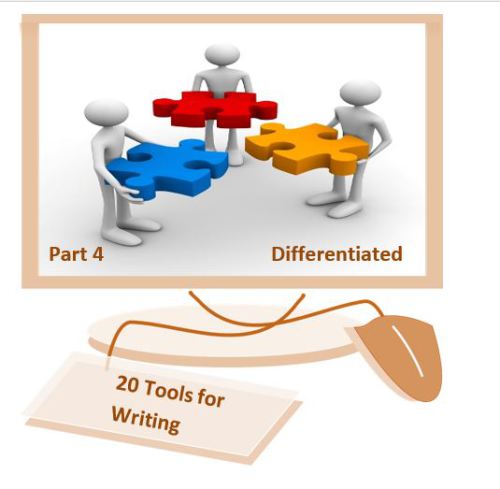20 Tech Resources and Tools for Differentiated Learning, Part 4: Writing Engagement


Welcome to the fourth post in a series designed to support the use of technology for differentiated learning… in and beyond the PBL classroom. Before reading, please take a moment to subscribe by email or RSS and also give me a follow on Twitter at mjgormans. I promise you will find some great information coming your way in the posts that follow…So sign up now and please pass this on with a retweet. – Mike Gorman (https://21centuryedtech.wordpress.com/)
Part 4: Tech Resources and Tools for Differentiated Learning … Writing Engagement
I do really hope you enjoyed the past three posts involving differentiated instructional tools for reading and writing using technology. In the last post of the series I focused on DI and the writing process. In this post, I wish to extend DI and writing in the area of student engagement. Before taking note of some of the tools and resources, lets take a moment to define what leads to student engagement in writing. While many of us would like to think that all of our students would be excited about writing the proverbial research or term paper… I ask you to think back to your own schooling. While we were learning the rules of grammar, citing sources, and turning research in to our own prose, many times we failed to both engage with and internalize the learning. I am a strong believer that it is only when we promote meta-cognition, that real learning happens. It is our students’ thoughts and ideas that must somehow make its way to the written word. I believe that scaffolding, chunking, and student engagement is an answer. I would like to emphasize student engagement in the DI process, although you will find that scaffolding and chunking are many times built right in to the resources I suggest. After-all, multiple lessons and activities are often the steps to the larger process.
We must remember that all students come to school with the innate interest to both learn and to share. Watch students in the primary grades during a “show and tell” session. It is usually filled with energy and passion. It really is exciting to communicate with others, when we have a sense of ownership. I believe that part of differentiation in writing is allowing students to share their interest, and also find the way they wish to share it. This can be done with a multitude of tools, that sooner or later lead to a formal publication. In this student ownership and choice, a new life filled with excitement for the subject and process are possible. Add to this, an authentic audience to publish for. Remember, “show and tell” does not happen in a void. Perhaps students determine the audience they wish to address, bringing about even deeper thought of how to deliver to that specific group. The idea of differentiated instruction actually transforms into that important student choice, honoring both interest, passion, and strength.
Before taking a look at the list of resource possibilities below, please note that the curriculum is still important. Students must still know how to cite a source, write with proper mechanics, and research for information. Through their choice of possibilities these areas become even more important. This ownership also allows for increased mental cognition… and we all know what that means. Enjoy the possibilities below, some might help with that final project, while others help you deal with different learning modalities as you scaffold the process. Discover even more DI tools for reading and writing in these past posts.
- Part 1: Tech Resources and Tools for Differentiated Learning … Reading
- Part 2: Tech Resources and Tools for Differentiated Learning … More Reading
- Part 3: Tech Resources and Tools for Differentiated Learning … Writing Process
The Twenty Tools
- Storybird – Discover this wonderful tool that allows students to see the illustrations first, and then do the writing. Best of all, they can publish for their parents, classmates, or even world. A great way to get creative writing from some beautiful illustrations for any grade.
- ReadWriteThink – While many teachers are aware of the lessons at ReadWriteThink , there is another area to check beyond the lessons. A closer look reveals a wonderful collection of interactive that can be used to scaffold process and promote engagement in writing.
- PicLit – Turn on the creative writing using some wonderful photographic images. This site uses words and photographs to inspire users to write, express themselves, and share their work with others. A picture can really state a thousand words while providing DI.
- Comic Master – Kids love reading graphic novels and comics. Perhaps they can also write their own. A Comic Master may include writing their own creative story, or explaining class content instead of a report.
- AMCI Storyboard – Are your students excited about making movies? Then they must learn that writing is part of the process. This is wonderful tool that helps students script and storyboard. They will want to write… and then make movies!
- PowToons – We all like comics… but how about moving comics? That is what PowToons is all about. Of course your students will need to write the script. The final production could explain curricular content, or be the end product of some creative writing.
- Weebly – The writing and outlining that goes into creating a web page is an important language art skill. An audience that includes the classroom, or the entire web sure beats the bulletin board. What story can your kids tell? Remember that it can be either fact or fiction!
- Classtools – Here is another site rich in resources and tools that can either scaffold learning, or be the final product. I wonder what George Washington’s Facebook Page might have looked like? And that is just one of many tools!
- ArtisianCam – Are your students ready to make your own picture books? Perhaps young students want to get creative, or older student want to write for younger ones. How about a book to explain a concept to others? Take a look and see the possibilities!
- Zoobursts – What about a resource that provides some unique digital storytelling possibilities? This is a tool that brings print to 3D. Now you might just understand where the word busts comes in.
- Story Jumper – How about an opportunity for your student to write their own books, or even publish a real book? Perhaps it is a whole class project as an adventure in PBL. This brings in a new dimension of DI. Imagine the engagement that an authentic book might bring.
- Primary Access – Discover this suite of free online tools that allows students and teachers to use primary source documents to complete meaningful and engaging learning activities with digital movies, storyboards, rebus stories and other online tools. This wide choice is certain to bring DI to their learning!
- Writing Prompts – You will be amazed, and so will your students at these highly engaging writing prompts. In fact, let them pick the prompt that pushes their possibilities to be prolific publishers.
- Phrasr – Put in the page and then picture the possibilities. A great way to get the creativity flowing while addressing those visual learners. Where might this fit in the scaffold?
- Kidblog – A great way to get those younger students blogging in a teacher monitored and controlled environment. Students become better writers as they write and critique each other. A great way to turn discussion into eventual prose!
- Edublog – The older students may enjoy the opportunity to write for even a bigger audience. Enjoy the discussions and reflections that can happen within a class, and between different classes. Watch engagement and skills increase as writing becomes real and purposeful.
- Young Writers Program – It is a contest for aspiring writers that happens each November. Look deeper in the site by clicking on Educators and discover a curriculum to promote writing. It really is an opportunity to provide your students a novel experience.
- Inklewriter – Your students probably enjoy one of those “choose your own outcome” books that provide an interactive reading adventure. This website turns your students from readers to writers. Imagine the PBL publishing possibilities!
- Plot Generator – This tools allows users to generate a plot after asking for some input. Great way to start that next story, novel, or video.
- Scholastic Story Starters – This is a wonderful interactive tool that provides students choice and ideas. It is great for those elementary age students just looking to write that story they can share in class or online.
I hope you enjoyed this list of possibilities.Please keep in mind that many of these resources and tools are interactive websites. It is important to check your district Acceptable Use Policy (AUP) and Terms and Privacy Policy of each website used. Make sure your students are practicing proper digital citizenship and responsibility when interacting and publishing on the web. Get parent permission and district authorization if needed. Enjoy the DI journey as your student engage in the writing process!
Tools and ideas to transform education. Sign up below.
cross-posted at 21centuryedtech.wordpress.com
Michael Gorman oversees one-to-one laptop programs and digital professional development for Southwest Allen County Schools near Fort Wayne, Indiana. He is a consultant for Discovery Education, ISTE, My Big Campus, and November Learning and is on the National Faculty for The Buck Institute for Education. His awards include district Teacher of the Year, Indiana STEM Educator of the Year and Microsoft’s 365 Global Education Hero. Read more at 21centuryedtech.wordpress.com.
